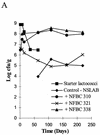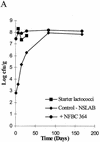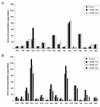Development of a probiotic cheddar cheese containing human-derived Lactobacillus paracasei strains
- PMID: 9603834
- PMCID: PMC106298
- DOI: 10.1128/AEM.64.6.2192-2199.1998
Development of a probiotic cheddar cheese containing human-derived Lactobacillus paracasei strains
Abstract
Cheddar cheese was manufactured with either Lactobacillus salivarius NFBC 310, NFBC 321, or NFBC 348 or L. paracasei NFBC 338 or NFBC 364 as the dairy starter adjunct. These five strains had previously been isolated from the human small intestine and have been characterized extensively with respect to their probiotic potential. Enumeration of these strains in mature Cheddar cheese, however, was complicated by the presence of high numbers (>10(7) CFU/g of cheese) of nonstarter lactic acid bacteria, principally composed of lactobacilli which proliferate as the cheese ripens. Attempts to differentiate the adjunct lactobacilli from the nonstarter lactobacilli based on bile tolerance and growth temperature were unsuccessful. In contrast, the randomly amplified polymorphic DNA method allowed the generation of discrete DNA fingerprints for each strain which were clearly distinguishable from those generated from the natural flora of the cheeses. Using this approach, it was found that both L. paracasei strains grew and sustained high viability in cheese during ripening, while each of the L. salivarius species declined over the ripening period. These data demonstrate that Cheddar cheese can be an effective vehicle for delivery of some probiotic organisms to the consumer.
Figures










References
-
- Andrews A T. Proteinases in normal bovine milk and their action on the caseins. J Dairy Res. 1983;50:45–55. - PubMed
-
- Blakesley R W, Boezi J A. A new staining technique for proteins in polyacrylamide gels using Coomassie Brilliant Blue G250. Anal Biochem. 1977;82:580–581. - PubMed
-
- Bourlioux R, Pochart P. Nutritional and health properties of yogurt. World Rev Nutr Diet. 1988;56:217–258. - PubMed
-
- Broome M C, Krause D A, Hickey M W. The use of non-starter lactobacilli in Cheddar cheese manufacture. Aust J Dairy Technol. 1990;45:67–73.
-
- Chapman H R, Sharpe M E. Microbiology of cheese. In: Robinson R K, editor. Dairy microbiology. London, United Kingdom: Applied Science Publishers; 1981. pp. 157–243.
Publication types
MeSH terms
Substances
LinkOut - more resources
Full Text Sources
Other Literature Sources

